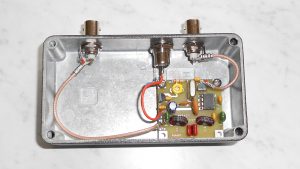After discovering my Yaesu FT-2000 receiver sensitivity is -75 dBm at 137 kHz, I needed something better to receive the 2200 meter band. The Jackson Harbor Press LF Converter was suggested. I was sent a kit by a friend. It is the previous version which uses FT-37-61 cores for the inductors in the low pass filter.
 Assembly was quick and easy, taking about an hour. I modified the low pass filter slightly since I wanted to concentrate on 2200 meters and have maximum rejection of the medium wave broadcast band. I mounted mine in a Hammond die cast box with BNC connectors for RF input/output and a coaxial power jack for 13.8VDC.
Assembly was quick and easy, taking about an hour. I modified the low pass filter slightly since I wanted to concentrate on 2200 meters and have maximum rejection of the medium wave broadcast band. I mounted mine in a Hammond die cast box with BNC connectors for RF input/output and a coaxial power jack for 13.8VDC.
My signal generator minimum output is -137 dBm. This produced a very clear tone, so I estimate the converter MDS is at least -140 dBm. Next I measure IF leakthrough and found it to be on the order of 50 dB. I could detect a tone at a level of -90 dBm. This isn’t great, but noise on LF would mask another 30 dB or so of signal. In actual operation for about one week monitoring all night (half of this time with a 10 MHz IF, the other half 4 MHz) I have not detected any actual problems with signals on the IF frequency being heard.
That brings me to the subject of LO drift. There is less drift with the 4 MHz LO frequency, so that is the only one I made extensive measurements on. There is enough IF signal present at the converter output to amplify with one of my 2N5109 preamps and feed to my HP 5335A counter. It is winter here so the temperature in my shack varies slightly as the furnace cycles on and off. With the converter sitting on top of my rack mounted computer which gives off some heat I found a cyclic drift of between 0.8 and 1.3 Hertz after looking at several cycles. Each cycle was slightly unique. I lowered the thermostat by 6 degrees F and after allowing a few cycles for things to settle I looked at the drift again. It was about the same as before but everything had shifted up approximately 5 Hertz. After moving the converter to a location not influenced by heat from the computer, similar measurements were obtained. Overall the LO shifted down a couple of Hertz but the 0.8 to 1.2 Hz cyclic variation as the furnace cycled on and off remained mostly unchanged. I replaced the small trimmer capacitor with a fixed 22 pf NP0 ceramic and a 1-10 pf piston trimmer. This did not measurably improve the situation.
I find the converter very adequate for general LF listening and acceptable for casual WSPR monitoring on 137 kHz. The serious WSPR reporter will probably want better frequency accuracy than this converter can provide. For QRSS and DFCW the converter is not acceptable. This amount of drift will cause serious problems for those modes.
It is possible the LO could be stabilized with a crystal heater but since my FT-2000 has too much drift to be useful even if the converter were perfect I am not going to pursue that. Another option would be to use a precision OCXO in place of the onboard LO. Suitable units can be found on eBay for around $50.
